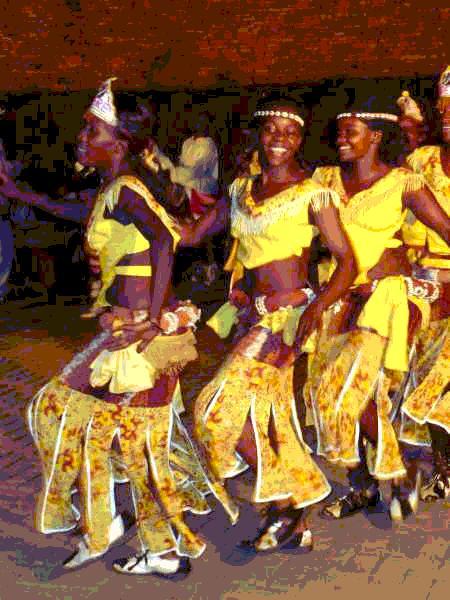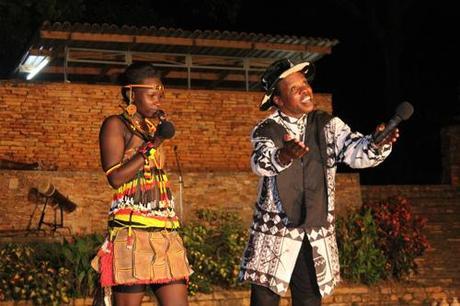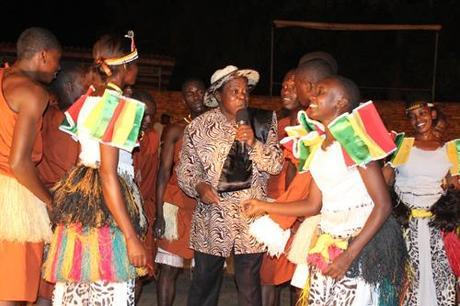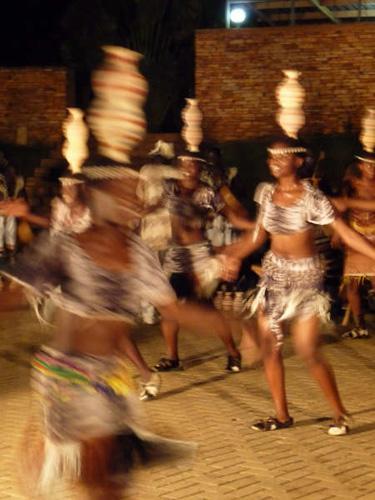The Culture of Uganda – in rhythm and dance
Tick-tick-tick goes the bamboo on the calabash.
Sh-sh-sh-shake the seeds in the gourd.
Thump-thump-thump thuds the stick on the taut hide of the drum.
The early evening air in the Ndere Centre’s ampitheatre fills with the rich, bass sound of the harp-like adungu.
Men beat the surface of the drum hard with the flat of their hands. The drumming rises to a crescendo as the women dancers elegantly descend the stairs into the open air Amphitheatre, all brilliant smiles and waving arms. And then it starts!
A group of twelve women shake their hips, moving to a joyful, seductive rhythm. They throw back their heads as they circle the floor to the sound of the dexterous plucking of the adungu. To one side of the stage, five men play a giant wooden xylophone.

Shake your kabina! The Culture of Uganda – in rhythm and dance. Photo courtesy of Stephen Legg
Ten drummers and acrobats in bark cloth tunics fly onto the stage, doing press ups and mock fighting and doing press-ups. They SLAP the sides of the drum with sticks. With big grins on their faces, the acrobats race towards the audience, arms flailing and legs akimbo, kicking left and right. Round and round they go. The energy of the Maggunju, the Royal welcome dance of the Baganda, holds the audience captive, ready for our musical and cultural tour of Uganda.
As our host – and cultural ambassador – Stephen Rwangyezi walks down through the audience to welcome us, a little white boy runs up to him and starts playing Stephen’s drum.
“Forget your problems – we are going to take you to the different parts of the country.” Stephen tells us. “Now WE are the donors” – he tells the predominantly Muzungu audience - as we have something in abundance to offer YOU!”

The Culture of Uganda – in rhythm and dance. Stephen Rwangyezi takes the audience on a musical, dancing tour of Uganda at the Ndere Cultural Centre. Photo Ndere.
In Western Uganda, it’s all about the cows.
We listen to the music played to relax the cows. “After walking 20 kilometres each way to drink water, wouldn’t you be stressed?” He asks. Even the okujumeera – the sound of cow mowing is developed into the singing while the thudding of their hooves – is reflected in the dance steps of Western Uganda.

Boys herding Ankole cattle
Through his anecdotes, Stephen reminds us of the continent’s enormous contribution to global culture. He illustrates how the traditional sounds of Africa can be heard in modern American rap music.
“Who is President Obama?” He asks, but “the Original Black African Managing America.”
We pass through Bunyoro and Toro “where love was first invented.”
We hear a haunting song from Ankole and then we move on to the upbeat sound of the West Nile and the adungu.
The Amphitheatre is filled with a frenetic whirl of colour and a flash of white teeth. KABINARIFIC! The women dancers whip up a storm on the dance floor. Fast and furious, how do the men play those drums so speedily? (I can’t even tap my fingers that fast).

Ndere Troupe Stephen Rwangyezi. The Culture of Uganda – in rhythm and dance. A musical, dancing tour of Uganda at the Ndere Cultural Centre. Photo Ndere.
We can’t pass through West Nile without a historical anecdote, of which there are many interweaved throughout the evening. Of Idi Amin, Stephen says “when he was in the country, people were scared. When he was out of the country, people were embarrassed.” He recounts how, time and again, cultural and language blunders rolled out of the then president’s mouth.
Later in the show, children are invited onto the open stage. 27 kids of all ages listen attentively to Stephen’s every word. It’s an unexpected highlight of the evening to see him invite each child to do their turn in the circle. I find it extraordinary to think that not so long ago this dancing was banned. (Even now colonial legislation still exists in Uganda that in theory makes traditional dancing illegal).
As the show draws to an end I recognise the unmistakable whistles of the music that made me first fall in love with Uganda.
The male dancers wear bright green beads around their waists over imitation (I hope) leopard skin tunics. Long colourful beads drape over their shoulders, criss-crossing at the waist. Their headdresses have white tuft-like tails. The women wear thin strings of beads around their foreheads.
“If you dance together you can never be at war.”

Shake your kabina! The Culture of Uganda – in rhythm and dance. Photo courtesy of Stephen Legg
The dancers genuinely seem to love what they do. There’s a great camaraderie and joking around between the dancers and Stephen. Their passion and playfulness is contagious.
How many shows are there in Uganda that you would rush to see more than three times?
“When people in our culture dance, you don’t let them suffer alone – you join in!” So just remember, next time you feel stressed, do as Stephen suggests: “shake your seating facilities.”
The Muzungu recommends:
Watching the Ndere Troupe perform takes me back to my first Kampala night out, courtesy of VSO. The show is a fantastic introduction to Uganda. It’s a real celebration of Africa and everyone should see it. I remember sitting on the edge of my seat thinking, “I’m finally here. I’m in Africa!”
The colour, the energy, the smiles and the humour, the stories… the whole experience was everything I’d imagined Africa to be and more.
Ndere Cultural Center entrance fees
Last published entrance fees below. Please check with the booking office first. Food, snacks and drinks are available.
15,000 shillings for children; 20,000 shillings for Ugandans; 30,000 for non-Ugandans.
How to book to see the Ndere Show
You can send an email to [email protected] or [email protected] or call +256 772 700105, +256 772 700 106 or +256 772 200 104
This article was originally commissioned by the Empazi Magazine, the brainchild of Ugandan creative Arnie Petit.
Have you visited Kampala’s Ndere Center yet? What was your favourite part of the show?
Tags:
Africa, African Dance, African Dances, Cultural Centre, culture, Culture Of Uganda, Dance Performances, East Africa, Kampala, Ndere, Rhythm And Dance, Stephen Rwangyezi, Tour Of Uganda, Traditional Dance, Uganda, Uganda Culture« Interview with a rebel: Ugandan cultural activist Stephen Rwangyezi 5 Years a Blogger »

